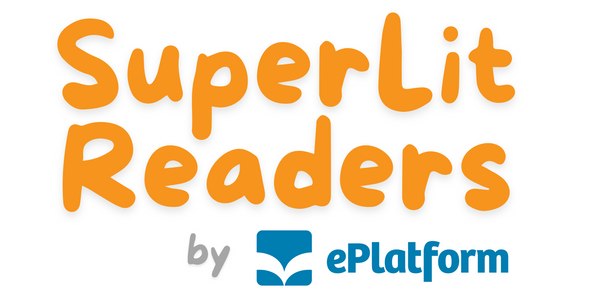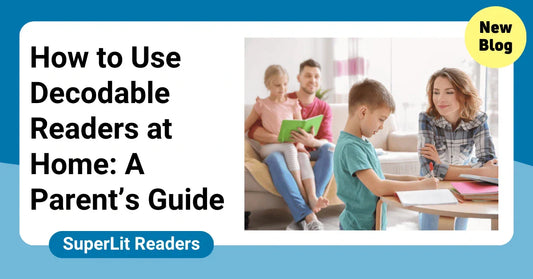Science of Reading Made Simple: Guide for Parents & Teachers

Overview of this Blog:
Let’s face it—helping kids learn to read can feel like trying to solve a puzzle blindfolded! With so many different teaching methods out there, how do you know what actually works? Well, strap yourselves in, because we’re about to dive into the Science of Reading—and trust us, it’s not as complicated as it sounds!
In this blog, we’re breaking down everything you need to know about this game-changing approach to how reading is taught to kids. Whether you’re a teacher trying to make sense of new methods or a parent wanting to support your little reader at home, we’ve got you covered with practical tips, real-world examples, and strategies that'll actually work. Plus, we’ll show you how SuperLit Readers can make this journey a whole lot easier (and more fun) for everyone involved!
Table of Contents:
1. What’s All This Talk About the Science of Reading?
2. The Famous Five: Breaking Down the Essential Components
3. Why Systematic Synthetic Phonics is Your New Best Friend
4. Decodable Readers: The Secret Weapon You Need
5. Making it Work in Real Life: Practical Tips
6. Common Questions (That Won’t Make Your Head Spin)
7. Your Next Steps: Getting Started Made Simple
1. What’s All This Talk About the Science of Reading?
Here’s the deal: The Science of Reading isn’t just another educational buzzword that’ll disappear faster than your coffee on a Monday morning. It’s actually decades of research that shows us exactly how our brains learn to read. Think of it like a GPS for teaching reading—it shows us the most reliable route to get from "What’s that letter?" to "Can I read just one more chapter?"
Important to Note: You know how some kids seem to pick up reading as easily as catching Pokémon, while others struggle? The Science of Reading explains why this happens and gives us proven strategies to help ALL kids succeed!
2. The Famous Five: Breaking Down the Essential Components
Listen, if reading were a superhero team, these 5 components would be your Avengers. Each component has its own superpower, and when they work together? Magic happens!
1 - Phonemic Awareness
Think of this as your child’s “sound radar.” It’s the ability to hear and play with individual sounds in words. For example:
- “What’s the first sound in 'dog'?”
- “What happens if we change the 'c' in 'cat' to 'h'?”
Fun fact: Kids who are good at hearing these sounds typically become stronger readers!
2 - Phonics: The Code Breaker
Remember those spy decoder rings you loved as a kid? That’s basically what phonics is! It helps kids crack the code of how letters and sounds work together. And let me tell you, when kids get this? Their faces light up like they’ve just discovered chocolate can be breakfast food!
3 - Fluency: The Smooth Operator
You know that feeling when you’re driving and everything just flows? That’s what reading fluency is like. No more robot voice—just smooth, confident reading that sounds as natural as talking.
4 - Vocabulary: The Word Collector
Think of this as your child’s mental dictionary. The more words they know, the better they understand what they read. It’s like upgrading from a basic cable package to Netflix Premium—suddenly, so much more makes sense!
5 - Comprehension: The Master of Understanding
This is where all the pieces come together—like solving a puzzle and finally seeing the big picture. When kids have strong comprehension skills, they don’t just read the words—they get lost in the story!
3. Why Systematic Synthetic Phonics is Your New Best Friend
Okay, don’t let the fancy name scare you off! Think of systematic synthetic phonics like building with LEGO blocks. You start with the basics (simple sounds) and gradually build up to more complex structures (words and sentences). No skipping steps, no guessing games—just clear, logical progress that makes sense. If you're interested in learning more about this method, check out our blog post on Systematic Synthetic Phonics: Explained.
4. Decodable Readers: The Secret Weapon You Need
Decodable readers are like treasure maps for emerging readers. They are carefully crafted books that contain words your child can decode using their phonics skills. Instead of feeling overwhelmed by complex texts, your young reader can confidently tackle stories that are just right for them.
Why Decodable Readers Matter:
- They boost confidence as kids successfully read their first stories.
- They reinforce the phonics skills your child is learning.
- They make reading fun and engaging, helping to foster a lifelong love of books! For tips on selecting the best books for your child, check out What to Look for When Choosing Decodable Readers.
5. Making it Work in Real Life: Practical Tips
Now that you know about the Science of Reading and the essential components, let’s talk about how to make it work in real life!
Create a Reading Routine
- Set aside dedicated time for reading each day.
- Choose a comfy spot to make reading enjoyable.
Use Decodable Readers
- Incorporate SuperLit Readers into your routine.
- Let your child choose the books they want to read!
Encourage Conversation
- Ask questions about the story to boost comprehension.
- Make it a two-way street—share your thoughts on the books too! For more insights on reading routines, don’t miss our article 3 Tips to Perfecting Your Child’s Reading Routine.
6. Common Questions (That Won’t Make Your Head Spin)
Q: Is the Science of Reading just another fad?
A: Not at all! It’s rooted in decades of research and proven strategies.
Q: How do I know if my child is making progress?
A: Look for increased confidence, improved fluency, and a greater understanding of the stories they read!
Q: Can I use regular books, or do I need decodable ones?
A: While regular books are great for enjoyment, decodable readers are designed to build specific skills in young readers. To understand when to introduce these materials, refer to our post When Should Children Start Using Decodable Readers.
7. Your Next Steps: Getting Started Made Simple
Ready to dive into the Science of Reading with your child? Here are a few simple steps to get started:
- Explore Decodable Readers: Check out the selection of SuperLit Readers to find books that are perfect for your child’s reading level. Shop Now.
- Implement Phonics Practice: Use fun games and activities to reinforce phonics skills at home.
- Keep Learning Together: Engage with your child’s reading journey by asking questions and discussing the stories you both read.
— Happy Reading!






